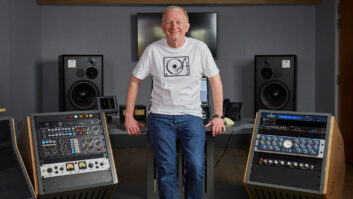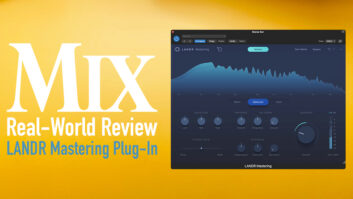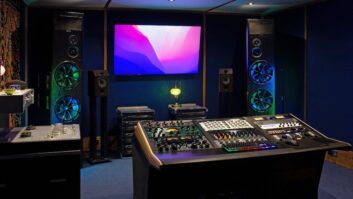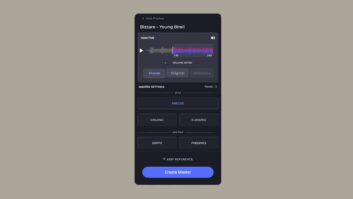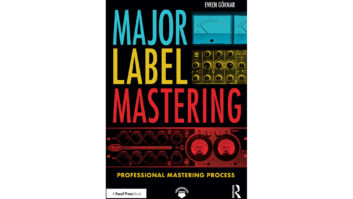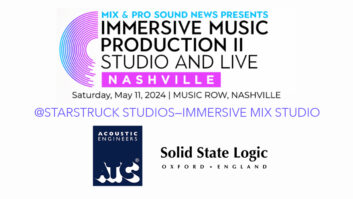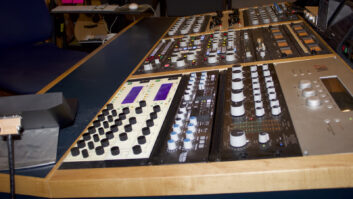When mastering engineers began working in the 5.1-channel domain in the mid- to late ’90s, they had few tools at their disposal and little experience from which to draw. Tales abound of jury-rigged systems, chain-linked pairs of processors that didn’t necessarily function as a unit, and vast amounts of experimentation with speaker placement, bass management, DVD authoring and other aspects of post-production.
We’ve come a long way, baby. Today, the availability of state-of-the-art, purpose-built tools for mastering in discrete surround is equivalent to the momentum behind the formats that deliver the final product to the consumer: DVD-Video, DVD-Audio and Super Audio CD.
REBUILDING ROOMS FOR SURROUND
Those who have been pushing the surround envelope since the introduction of 5.1 have an especially deep appreciation for the evolution in the medium and in the tool set used to create material for it.
Gateway Mastering & DVD owner/engineer Bob Ludwig (see photo above) recently rebuilt his control room to better accommodate multichannel projects, adding an SPL MMC 1 surround console and a Z-Systems signal router/digital patchbay. “Going from stereo to 5.1 used to take me three to four hours, and it was nonbillable time,” Ludwig says. “With this new setup, I can reconfigure the room with the click of a mouse.” Ludwig’s speakers — Eggleston Works Ivys — also used to take hours to set up, but with the equipment upgrade, the control room’s physical redesign allows the speakers to live in closets when they’re not in use. For 5.1 sessions, they can be rolled into position within minutes.
The reconfiguration of Ludwig’s room illustrates the extent to which mastering engineers are factoring 5.1 into the equation. Los Angeles-area veteran Stephen Marcussen has also shifted into surround mode recently. “I’ve been literally in 5.1 mode for five to six weeks solid,” says Marcussen, noting that he’s mastered projects for the likes of Shania Twain, Ben Harper and the Rolling Stones. “In the past [financial] quarter, we have been solidly doing DVD-Video. There was a point when I didn’t do a [stereo] album for two weeks.”
Marcussen adds that as 5.1 formats have matured, the quality of the work he’s receiving for surround mastering is improving. “The stuff is sounding better and better,” he says. “People are really mixing for it and doing a great job. People are paying close attention to the soundfield and not doing odd things like having a triangle going from left to right behind the listener. It’s settled into a place where it’s more about the balances and the effects than about gimmicks.”
Although audiophile engineers like Ludwig and Marcussen are working on an increasing volume of DVD-A and SACD releases, they acknowledge that the lion’s share of the surround mastering work is still in DVD-Video, which requires lossy compression to deliver six discrete channels. “Lately, it’s been more DVD-Video,” says Ludwig, “in spite of the fact that there’s quite a lot of action in the SACD thing, now with Universal putting out releases in both DVD-A and SACD.” Marcussen agrees, saying, “The common denominator is video. I see the value in any hi-res system, but does the world at large see the value in a hi-res system? I don’t know if they see it today, but because I’ve always believed in quality, I think that in the future, both SACD and DVD-A may co-exist or one may go away, but there will be at least one hi-res system out there.”
FOCUSING ON SPECIALTY MARKETS
While the various formats compete for public acceptance, each has built enough momentum to spawn niche businesses catering to specific areas. For instance, Herbert Waltl of L.A.-based Media Hyperium has distinguished himself as a leading SACD transfer and mixing expert. In fact, Media Hyperium has been recognized by Philips as a reference SACD studio.
“We’ve done a huge project for Concord Records here where they’ve reissued 30 albums on SACD,” says Waltl. “We’ve done a lot of transfers and mixes, mostly from analog sources, some of which had to be baked. It was mostly 16- and 24-track, 2-inch tape, except for one that was 32-track analog — with two 16-track decks synched together — and a couple that came in on 3348 and Pro Tools|HD.”
Waltl and his chief engineer, Ted White, mix through an API Legacy console using state-of-the-art analog processors, converting through Meitner and dCS converters into linked Merging Technologies Pyramix systems. “The Pyramix can sync up with timecode, so we run systems together and lock them to sync,” says Waltl. “It works beautifully. From a professional point of view, the system suits our needs best because it allows us to work like a regular studio. It makes DSD feel like a real-world system, rather than an ultrabeta, supersecret system.”
Another facility that has carved a niche for its SACD premastering expertise is New York’s Magic Shop, where owner Steve Rosenthal built a new room, the Blue Room, to accommodate SACD transfers for the Rolling Stones’ recent Abkco reissue program, as well as other work for Abkco, the Alan Lomax library and other clients. Rosenthal says that he decided to create the Blue Room last year after spending time at the SACD booth at the 2001 AES show and being impressed with the sound of DSD. “I just fell in love with how SACD sounded,” says Rosenthal, “so I decided to delve into it. I figured, if we want to get people interested in music again, it might be good for music to sound good again.” His suite features a Sony Sonoma DSD workstation with Ed Meitner converters, a Sonic Solutions 24-bit, 96kHz system with Mytek converters, and a customized Ampex ATR-102 analog mastering deck.
While music-intensive reissues like the Concord catalog and Pink Floyd’s classic Dark Side of the Moon represent one side of the 5.1 remastering universe, there’s an increasingly wide range of audio projects that have less to do with music than with sound-for-picture. One facility in Nashville, KK Proffitt and Joel Silverman’s JamSync, has made a specialty of remastering, remixing and restoring recordings from clients outside of the mainstream music industry.
“We don’t work much with major labels,” says Proffitt. “We didn’t want to compete with the studios that are geared for that part of the pie, so we decided to go after markets that others wouldn’t go after, like independent filmmakers, electronic press kits, and corporate, educational and vanity projects; basically, any video projects that need audio.”
Among JamSync’s clients are the Nashville Regional Transit Authority, for which the facility did audio sweetening and post-production; the Sudekum Planetarium, which hired JamSync to create show DVDs and sound system tuning; and Zenith, which used the company’s services for a 5.1 demo for its HDTV line. “Some of the projects we get are fascinating and they require a lot of audio attention,” says Proffitt. “On some of the restoration-oriented projects, we learn a lot about archiving formats.”
A hallmark of JamSync’s success is that the facility has doubled its bookings every year since it opened in 1998. “In today’s industry, that’s a difficult thing to do,” observes Proffitt. “But we’ve managed to pull it off by taking a broad-based approach. I’ve always considered myself an audio engineer, and I’m willing to deal with audio of any kind; it doesn’t have to be music.”
Like other mastering and post-production studios, JamSync has also broadened its offerings to include DVD authoring. Bob Ludwig’s Gateway Mastering & DVD was among the first to go the authoring route, and other prominent audio facilities that offer authoring services include New York’s Masterdisk, Boston’s DVDLabs and New York’s Sterling Sound (through its authoring affiliate, Metropolis DVD).
AUDIO QUALITY IS KING
Whether mastering studios perform authoring services in-house or contract them to third parties, all of the engineers interviewed here maintain an intense focus on sound quality, and they employ a wide variety of tools to achieve their results.
Ludwig’s choice processors include the TC Electronic System 6000 multichannel processor; the Z-Systems z-Q6 and z-CL6 multichannel EQ and compressor/limiter, respectively; and Weiss Engineering digital EQs and de-essers. In the analog domain, Ludwig gravitates toward GML, Avalon, Manley and other manufacturers of reference-grade processors. Although Ludwig finds himself using more and more plug-ins in various workstations — including Digidesign Pro Tools, Steinberg Nuendo, SADiE and Sonic Solutions — he still prefers hardware to software when it comes to processing.
By the same token, Marcussen relies on a combination of vintage analog and next-generation digital tools. For DVD-Video and DVD-Audio projects, he has no qualms about using PCM processors, both in the stand-alone hardware and software domains. However, Marcussen’s console is a custom-built analog model, reflecting his desire to keep his options open until there is some consensus on high-resolution digital formats.
While many engineers lament the slow pace with which manufacturers are introducing advanced multitracking, editing and processing software for DSD, Marcussen finds the paucity of digital tools refreshing. “Working in DSD, because of the limited arsenal of digital tools, I have to rely on my chops as opposed to a peak limiter,” he observes. “I’ve gotta get into the music, wrap my head around it, and say to myself, ‘The choruses have to take off and the bridges have to take you to the moon.’ It’s like the days of vinyl. It makes you a better engineer.”
CREATING SURROUND: REAL-WORLD SITUATIONS
Marcussen is not a fan of extracting surround information from stereo sources. In fact, you won’t find many audio engineers who enjoy that process. However, in the real world, situations often arise when multichannel extrapolations are necessary.
“It comes up quite a lot,” says Ludwig. “Ninety-nine percent of the time, when you’re dealing with a discrete mix, some element will need to be added at the last second that there’s no 5.1 for. Welcome to the world of video! Very often, a video person did all of the editing without regard to audio, and the audio person did all the mixing without regard to video. Suddenly, reconforming those things becomes our job. There might be a piece of applause that never got mixed and it needs to be in there, so those are times when we need to make a fake 5.1. A little thing like that, which might last only 20 seconds, could take an hour-and-a-half to create.” Ludwig’s favored tools for multichannel extrapolation include the TC Electronic UnWrap algorithm and the Z-Systems z-K6 processor.
Another real-world scenario that comes into play in high-end mastering suites is the need to monitor a multichannel mix in an alternate environment. For that purpose, Ludwig built two listening rooms: One is equipped with smaller versions of his professional Eggleston monitors, while the other features a consumer-level Bose home-theater setup.
How often does Ludwig take his surround material into the Bose room for a monitoring check? “Always,” he says, “and I underline that ‘always.’ Most of the time, things translate beautifully between the big room and that system, and we’ve calibrated the Bose as best as we can for that room. But there are times when I’ll be mastering something in my room and then bring it into the Bose room and find that the low end sounds different. A lot of this is a function of what the mixing engineer has done with the LFE. If it’s a blend of other channels, the Bose reacts a certain way; if it’s discrete, like the kick and the lower end of the bass guitar and toms, it reacts differently. The beauty of the Bose, as well as other systems from JBL and others, is that it’s so severely bass-managed it’ll give you a good idea of how those systems are going to treat that info. The bottom line is, I wouldn’t think of doing a surround session without checking it in that room.”
Although the Bose system is relatively inexpensive, customizing it to accept uncompressed multichannel signals was costly, according to Ludwig. “You’ve got to have three dCS sample converters, which are in the neighborhood of $6,000 to $7,000 apiece, as well as a professional Dolby encoder in the chain in order to feed, say, a DSD source into it,” says Ludwig. Still, he is known as an engineer/studio owner who will spare no expense to achieve the best sound. If taking that extra step to hear it through a consumer-level system can result in even the slightest adjustment in the bass content, Ludwig is all for it.
Other engineers share Ludwig’s determination to push the envelope in 5.1-channel sound. Media Hyperium’s White says, “As an engineer, I feel strongly that my job is to serve the artist and the client with the best available tools. I’m not going to tell somebody that PCM 44.1 is not that much different from DSD or high-sampled PCM, because people can hear for themselves that it is. This is not the emperor’s new clothes. We’re really trying to make a difference.”
Paul Verna is a longtime professional journalist.
